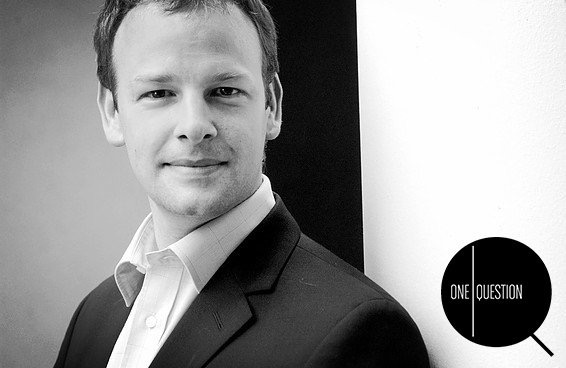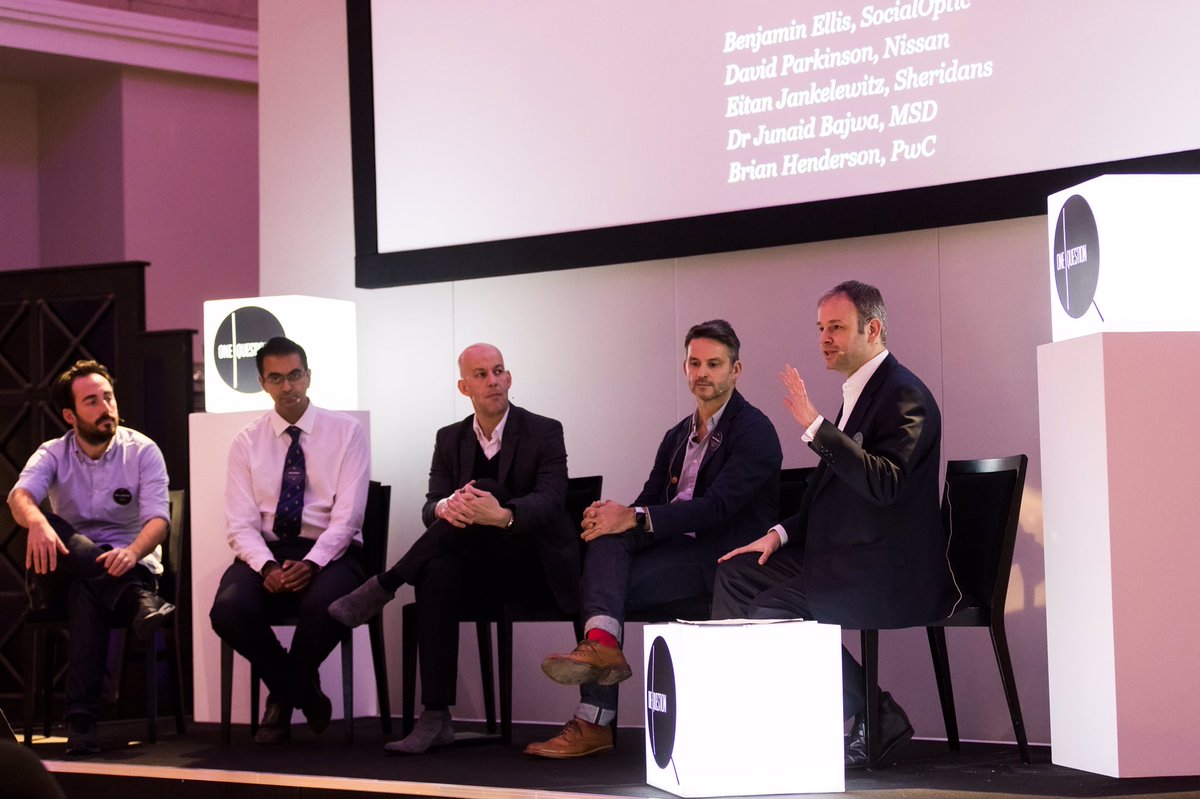It is rare to get to an event that stretches your brain, but the One Question conference was such an event. “How do we successfully marry technology and humanity?” This isn’t an overview of the whole day – that would be a book rather than a blog post – and there is a book (One Edition) from the day which is complete with cartoons by Gaping Void. This is a summary of the panel I chaired, the things that were said, and something that wasn’t.
 I started off the panel by realizing quite what a cyborg I have become. I was separated from my laptop, and therefore my notes. As is the case for many of us today, my computer has become an extension of my brain. Without it I am limited to basic functional tasks, like fetching a coffee and gazing at the sky. Ok, perhaps it isn’t quite that dramatic, but most of us do depend on technology to get our job done, regardless of which industry you are in, as now a days you can do all the work from a computer or even investing tasks like fx trading online for France which is important for business people. I’ll come back to “gazing at the sky” but for now, safe to say I was rescued by “the cloud” as my notes had synced to my phone. Onwards…
I started off the panel by realizing quite what a cyborg I have become. I was separated from my laptop, and therefore my notes. As is the case for many of us today, my computer has become an extension of my brain. Without it I am limited to basic functional tasks, like fetching a coffee and gazing at the sky. Ok, perhaps it isn’t quite that dramatic, but most of us do depend on technology to get our job done, regardless of which industry you are in, as now a days you can do all the work from a computer or even investing tasks like fx trading online for France which is important for business people. I’ll come back to “gazing at the sky” but for now, safe to say I was rescued by “the cloud” as my notes had synced to my phone. Onwards…
The Finance, The Healthcare, the Legal and the Automotive Perspective
Perhaps an inauspicious title for a panel, but while the rest of the day looked at the creative industry, music, media, investors and virtual reality, this was where we got to explore how “traditional” business is integrating technology and humanity. Of course, these industries are far from traditional, especially in the ways that they are starting to use technology. It was an insightful group of expert panelists: Dave Parkinson from Nissan, Brian Henderson from PwC, Dr Junaid Bajwa from MSD and Eitan Jankelewitz from Sheridans. Each one of them could have talked for hours on the impact of technology on their industry; we had 30 minutes. Focus, as a VC once said to me, is a very important thing.
Automotive
Friends will know me as something of a reformed petrol-head, having spent many years driving around in a V8 sports car, before moving to an ever-so-slightly greener electric vehicle. So, it will be of no surprise that I follow the automotive industry quite carefully. I love driving my PHEV, it is still a “man and machine” thing, but a slightly different kind of relationship, and one in which the car may, in the future, file for divorce. You will almost certainly be aware of the emergence of autonomous vehicles, either via Google’s initiative or Tesla, but technology is having a huge impact across the industry in ways that have, and are, changing society.
The journey towards autonomous vehicles isn’t quite as binary as much of the press would have you believe. As science writer Ben Goldacre wrote, “I think you’ll find it is a bit more complicated than that“. Dave introduced a very helpful model: feet off, hands off, eyes off, brain off. This isn’t a description of a particularly bad management meeting, it is the journey towards self-driving cars. We have “feet off” today, with cruise control – even your trust Anti-locking Brakes relieve the driver of foot control. Tesla, until recently, had hands off capability, and a number of manufacturers have forms of self-parking or park assist. Eyes off and brains off are further away, with many of the barriers more to do with regulation and societal views, rather than technology.
The journey towards self-driving cars may be a longer and smoother one than many expect. When they do come they will transform the insurance industry, public transport, parking and household finances – for many households, second to owning a property, owning a car is their largest expense. Transport accidents are one of the largest causes of early death, but we managed not to stray onto the trolley problem – you can read up on that for yourself. The technology journey that started with cruise control and ABS is making driving a safer, if less human, experience. I am sure many people will still drive, but perhaps for fun, rather than function.
Healthcare
I spend a good percentage of my time working in and around the healthcare space, where technology is allowing DNA sequencing to be used to transform the understanding and treatment of patients. However, the pace of technology transformation isn’t evenly spread; it isn’t unusual to find a GP surgery managed by an old PC running Windows 2000, with software that would horrify anyone who has worked in IT within the last decade.
Junaid helped us explore how technology is changing the patient experience, and how important it is to start with the right question: What do we want technology to achieve for patients? Technology for technology’s sake has no place in health care. We are certainly a long way from a GP “chat bot” to look after us, but the Internet is providing support and information for patients today. Hopefully in the future it will also make the process of accessing healthcare more straightforward, reducing the burden on accident and emergency services, which too often become the point of first resort. With increasing costs, an ageing population, and more of us surviving with not just one chronic condition, but multiple health care issues, the healthcare system needs technology to manage to increasingly complexity.
Legal
Law is complex, but it is also quite repetitive, which provides opportunities for automation. Due-diligence work consists of looking through thousands of documents to pull out and summarize key information. Today law firms are using AI to automate this process, and that is just the beginning of what AI might bring to the legal world.
Eitan suggested that technology may make legal advice more accessible, with the potential to automated simple enquiries, ensuring that we are better protected and better served. But there is also a flipside. Due-diligence work is often a “rite of passage” for young lawyers, helping to familiarise them with their industry. Is that a necessary rite of passage? That is an open question, and technology may help them come up with more robust answers than previous generations of the profession – a lawyer with a bot army of para-legal assistants perhaps. Earlier in the day Rory Sutherland reminded us that such investments of time are often a necessary signal of commitment, and an unusual guarantee of quality, for example “The Knowledge” taken by London taxi drivers. If you have to work hard to get the right to perform a job, it is more likely that you will work hard to ensure that you do it well and don’t take risks with your right to perform it.
Finance
Finance has been transformed by technology. From automated trading, to computerised accounting, technology runs the show. Has that eliminated humans from the industry? In an echo of what happened in the car industry with the introduction of robots, we encounter the productivity paradox once again. The productivity improvement from technology ends up in increased output and quality, rather than a reduced workforce. Just as robots freed up resource to focus on quality and new product features in the auto industry, so they have in the finance word. Brian pointed out that we have better quality accounts and accounting because of technology. That enables better human interaction as accountants are freed up put their time into helping businesses at a human level.
And What I Didn’t Say…
Going back to where I started the day, at Farnborough Station with the sun streaming across the platform, low in the sky. Almost anyone who goes down the path to psychological research is, or becomes, an avid people watcher. I particularly pay attention to how people use technology, and how they interact with it, when I’m in a public space. Watching the commuters on that packed platform, and casting my mind back to when I first stood there a decade and a half before, I noticed that the newspapers were long gone, and no-one was talking to each other, let alone staring into space thinking. Every face was focused on a screen, be it a mobile, iPad or an eBook device. I have to say that not a single person looked particularly happy, or particularly alive. Suddenly, from the far end of the platform, there was a squeal of delight. A small child, knee-high to a grasshopper, was bouncing up and down. “Mummy, mummy!” he said, “look how BIG my shadow is!” And he danced with his shadow, yelping with delight all the while.
In one of the question and answer sessions earlier in the day, the speaker was talking eloquently, then stopped and said “I’m sorry, I think I’ve forgotten what the question was?” That might be a metaphor for our use of everyday technology. It works, but we all too easily forget our humanity because of it. I hope that we can, by solving the major challenges we face, be they health or transport, or managing a well-functioning, global economy, that technology will leave us free to focus on that most important of questions: What does it mean to be human? How can we rediscover the joy of being comfortable in the knowledge of who we are. Enjoy the technology that surrounds us, but remember, every so often, to dance with your shadow.






